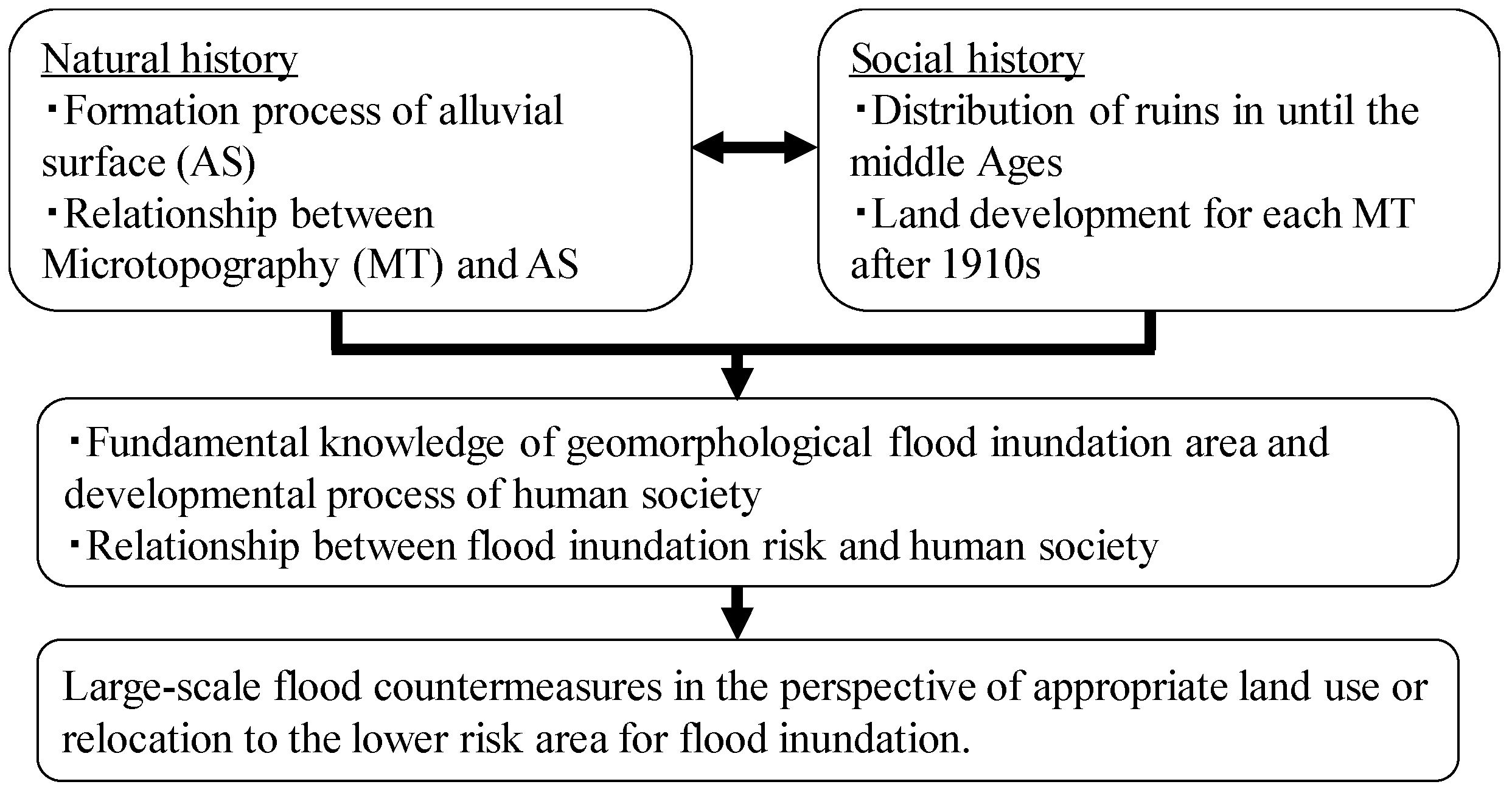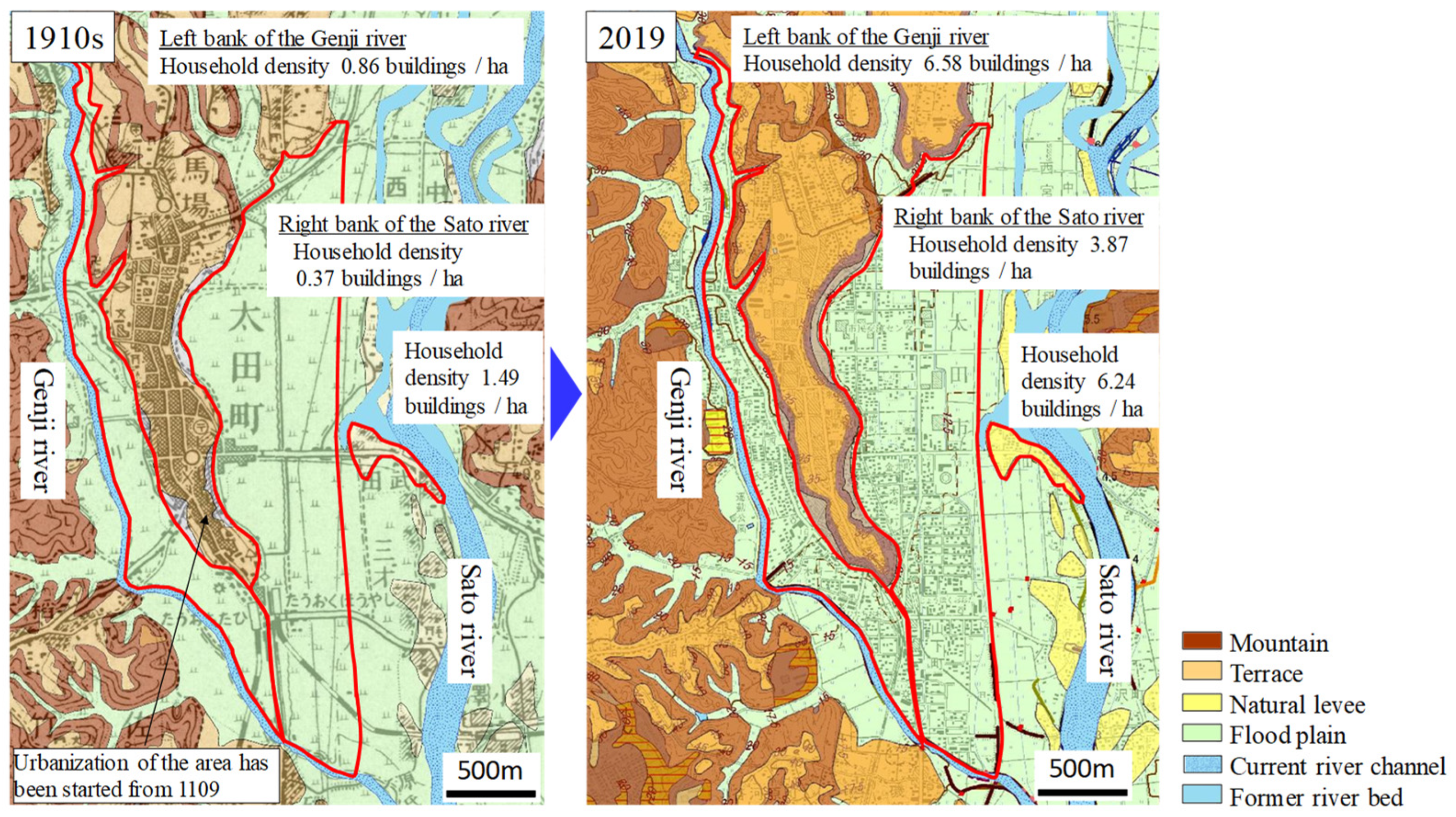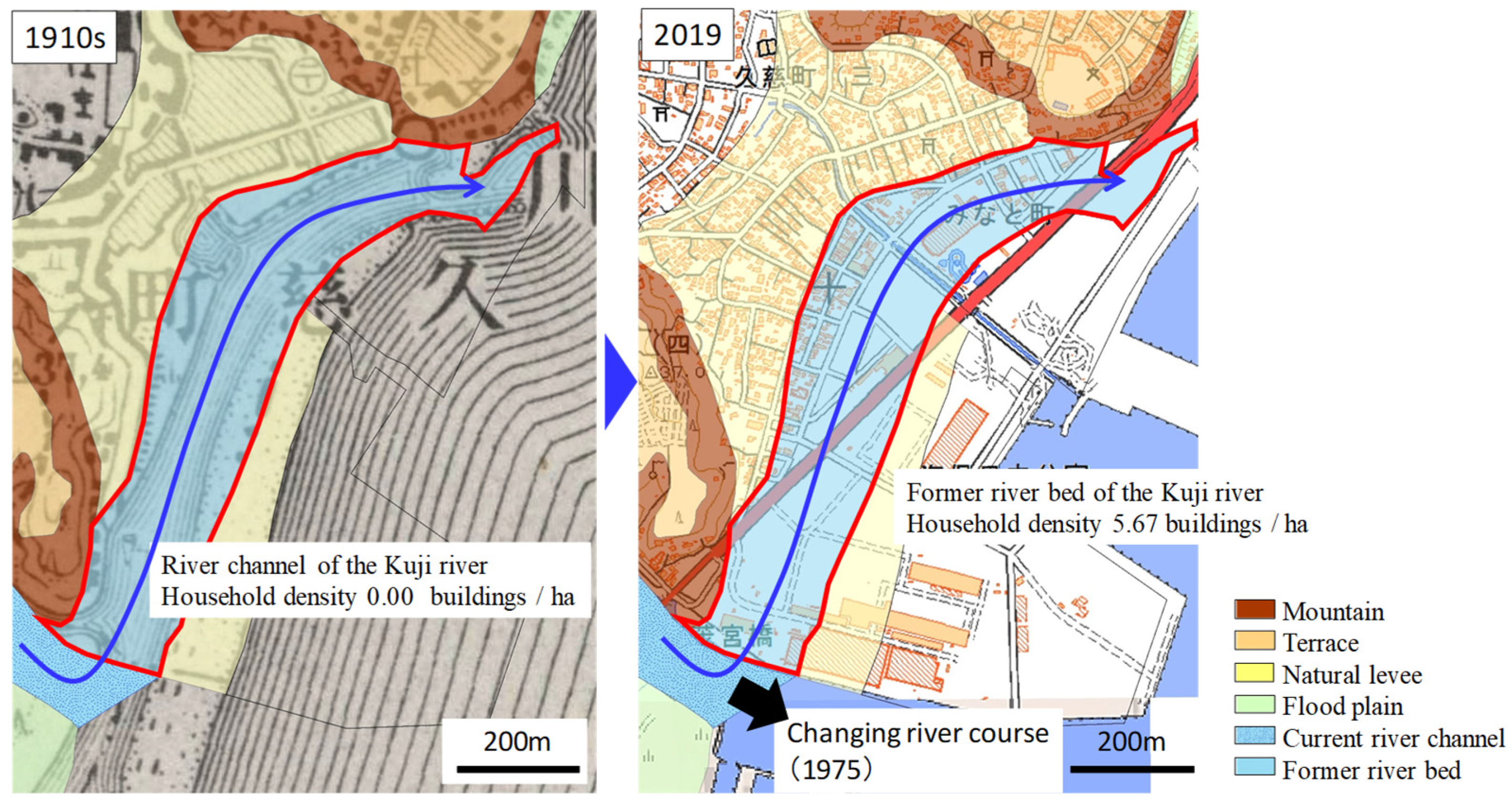Influence of Microtopography and Alluvial Lowland Characteristics on Location and Development of Residential Areas in the Kuji River Basin of Japan
Abstract
:1. Introduction
2. Methods
2.1. Location of Study Area
2.2. Literature Investigation of Land Formation Process in Lowlands
2.3. Relationship between Distribution of Ruins and Microtopography
2.4. Relationship between Modern Village Development and Microtopography
2.5. Statistical Analysis
3. Results and Discussion
3.1. Topographical Formation Process of Lowland Area in KR Basin
3.2. Microtopography and Village Development Process from Paleolithic Period to Early Modern Period
3.3. Microtopography and Village Development Process after 1900s
3.4. Relationship between Alluvial Surface and Village Development
4. Conclusions
Author Contributions
Funding
Conflicts of Interest
References
- Sanyal, J.; Lu, X.X. Application of Remote Sensing in Flood Management with Special Reference to Monsoon Asia: A Review. Nat. Hazards 2004, 33, 283–301. [Google Scholar] [CrossRef]
- Kundzewicz, Z.W.; Lugeri, N.; Dankers, R.; Hirabayashi, Y.; Döll, P.; Pińskwar, I.; Dysarz, T.; Hochrainer, S.; Matczak, P. Assessing river flood risk and adaptation in Europe—Review of projections for the future. Mitig. Adapt. Strat. Glob. Chang. 2010, 15, 641–656. [Google Scholar] [CrossRef]
- UNDRR. 2018: Extreme Weather Events Affected 60m People. 2019. Available online: https://www.unisdr.org/archive/63267 (accessed on 14 October 2019).
- Mills, E. Insurance in a climate of change. Science 2005, 309, 1040–1044. [Google Scholar] [CrossRef] [PubMed] [Green Version]
- Chang, H.; Franczyk, J. Climate Change, Land-Use Change, and Floods: Toward an Integrated Assessment. Geogr. Compass 2008, 2, 1549–1579. [Google Scholar] [CrossRef]
- Güneralp, B.; Güneralp, I.; Liu, Y. Changing global patterns of urban exposure to flood and drought hazards. Glob. Environ. Chang. 2015, 31, 217–225. [Google Scholar] [CrossRef]
- Hu, P.; Zhang, Q.; Shi, P.; Chen, B.; Fang, J. Flood-induced mortality across the globe: Spatiotemporal pattern and influencing factors. Sci. Total Environ. 2018, 643, 171–182. [Google Scholar] [CrossRef] [PubMed]
- Barredo, J.I. Major flood disasters in Europe: 1950–2005. Nat. Hazards 2007, 42, 125–148. [Google Scholar] [CrossRef]
- Changnon, S.A. Assessment of Flood Losses in the United States. J. Contemp. Water Res. Educ. 2008, 138, 38–44. [Google Scholar] [CrossRef]
- IPCC. Summary for Policymakers. In Climate Change 2013: The Physical Science Basis; Contribution of Working Group I to the Fifth Assessment Report of the Intergovernmental Panel on Climate Change; Cambridge University Press: Cambridge, UK; New York, NY, USA, 2013. [Google Scholar]
- Sato, A.; Kawagoe, S.; Kazama, S.; Sawamoto, M. Evaluation of flood damages by numerical simulation and extreme precipitation data. Proc. Hydraul. Eng. 2008, 52, 433–438. [Google Scholar] [CrossRef]
- Tachikawa, Y.; Takino, S.; Fujioka, Y.; Yorozu, K.; Kim, S.; Shiiba, M. Projection of river discharge of Japanese river basins under a climate change scenario. J. Jpn. Soc. Civ. Eng. 2011, 67, 1–15. [Google Scholar] [CrossRef] [Green Version]
- Kadomatsu, T. River Council’s Report on “Basic Policies of Water Resources Management for the 21st Century”. Water Sci. 2000, 40, 83–107. [Google Scholar]
- Ministry of Land, Infrastructure, Transport and Tourism; Water and Disaster Management Bureau; River Planning Division; River Planning Coordination Office. Interim report of Climate Change Adaptation to Cope with Water-related Disasters due to Global Warming: Share the disaster risk information and sense of crisis, to society to tackle disaster risk reduction. Public Works Manag. J. 2015, 442, 12–15. [Google Scholar]
- Hall, J.W. Handling uncertainty in the hydroinformatic process. J. Hydroinform. 2003, 5, 215–232. [Google Scholar] [CrossRef] [Green Version]
- Hall, J.W.; Penning-Rowsell, E.C. Setting the scene for flood risk management. In Flood Risk Science and Management; Faulkner, H., Pender, G., Eds.; Blackwell: Oxford, UK, 2011; pp. 3–16. [Google Scholar]
- Faulkner, H.; McCarthy, S.; Tunstall, S. Flood risk communication. In Flood Risk Science and Management; Faulkner, H., Pender, G., Eds.; Blackwell: Oxford, UK, 2011; pp. 386–406. [Google Scholar]
- Burns, D.H. Evaluation of regional flood frequency analysis with a region of influence approach. Water Resour. Res. 1990, 26, 2257–2266. [Google Scholar] [CrossRef]
- Ward, P.J.; Bouwman, A.; Bierkens, M.F.P.; Ligtvoet, W.; Winsemius, H.C.; Jongman, B.; Weiland, F.S.; Van Beek, R. Assessing flood risk at the global scale: Model setup, results, and sensitivity. Environ. Res. Lett. 2013, 8, 044019. [Google Scholar] [CrossRef]
- Yue, S.; Ouarda, T.; Bobée, B.; Legendre, P.; Bruneau, P. The Gumbel mixed model for flood frequency analysis. J. Hydrol. 1999, 226, 88–100. [Google Scholar] [CrossRef]
- Teng, J.; Jakeman, A.; Vaze, J.; Croke, B.; Dutta, D.; Kim, S. Flood inundation modelling: A review of methods, recent advances and uncertainty analysis. Environ. Model. Softw. 2017, 90, 201–216. [Google Scholar] [CrossRef]
- Rodríguez-Gaviria, E.M.; Ochoa-Osorio, S.; Builes-Jaramillo, A.; Botero-Fernández, V. Computational Bottom-Up Vulnerability Indicator for Low-Income Flood-Prone Urban Areas. Sustainability 2019, 11, 4341. [Google Scholar] [CrossRef] [Green Version]
- Garcia-Ayllon, S. Long-Term GIS Analysis of Seaside Impacts Associated to Infrastructures and Urbanization and Spatial Correlation with Coastal Vulnerability in a Mediterranean Area. Water 2018, 10, 1642. [Google Scholar] [CrossRef] [Green Version]
- Mishra, B.K.; Rafiei Emam, A.; Masago, Y.; Kumar, P.; Regmi, R.K.; Fukushi, K. Assessment of future flood inundations under climate and land use change scenarios in the Ciliwung River Basin, Jakarta. J. Flood. Risk. Manag. 2018, 11, S1105–S1115. [Google Scholar] [CrossRef]
- Merz, B.; Kreibich, H.; Thieken, A.; Schmidtke, R. Estimation uncertainty of direct monetary flood damage to buildings. Nat. Hazards Earth Syst. Sci. 2004, 4, 153–163. [Google Scholar] [CrossRef] [Green Version]
- Hall, J.W.; Tarantola, S.; Bates, P.D.; Horritt, M.S. Distributed Sensitivity Analysis of Flood Inundation Model Calibration. J. Hydraul. Eng. 2005, 131, 117–126. [Google Scholar] [CrossRef]
- Werner, M.; Blazkova, S.; Petr, J. Spatially distributed observations in constraining inundation modelling uncertainties. Hydrol. Process. 2005, 19, 3081–3096. [Google Scholar] [CrossRef]
- Oya, M. Topographical survey map of the middle and lower courses of the Kanogawa river basin showing classification of floods stricken areas. Geogr. Rev. Jpn. 1960, 33, 156–162. [Google Scholar] [CrossRef] [Green Version]
- Iwatsuka, S. The Character of Flood Damages caused by Kanogawa Typhoon. Geogr. Rev. Jpn. 1960, 33, 97–104. [Google Scholar] [CrossRef]
- Nagumo, N.; Kubo, S. 2011 Flooding and Fluvial Micro Landforms in the Cambodian Lower Mekong Plain. E-J. GEO 2013, 8, 141–152. [Google Scholar] [CrossRef] [Green Version]
- Hiramatsu, Y.; Yasui, S.; Urabe, A.; Hongo, M. Flood Disaster along Kariyata River Caused by Heavy Rainfall on 13 July 2004, Niigata Prefecture, Central Japan-The Relation of the Current Processes of the Flood to the Landforms. J. Jpn. Soc. Eng. Geol. 2005, 46, 153–161. [Google Scholar] [CrossRef]
- Yamamuro, T. The Location of the Remains of Yayoi Age in Okayama Plain. Jpn. J. Hum. Geogr. 1979, 31, 437–448. [Google Scholar] [CrossRef]
- Iseki, H. Changes on the Deltaic Plains in Japan. Quat. Res. 1972, 11, 117–123. [Google Scholar] [CrossRef]
- Ando, M. The Inhabitants’ Life in the Lowland of the Kiso, Nagara and Ibi Rivers. J. Geogr. 1988, 97, 91–106. [Google Scholar] [CrossRef]
- Tanabe, T.; Okuma, T. A Study on the Roles and Effects of “NOKOSHI” on the Jobaru-River Basin: Example of Flood Control that Allows Overflowing and its Future Possibility. Hist. Stud. Civ. Eng. 2001, 21, 147–158. [Google Scholar]
- Ueno, T. On some problems in river administration and flood control measures fitting in the twenty-first century. Disaster Prev. Res. Inst. Annu. 2001, 45, 433–448. [Google Scholar]
- Nakamura, F.; Shimatani, Y.; Nishihiro, J.; Ohtsuki, K.; Itsukushima, R.; Yamada, H. Investigation team for the 2015 flood disaster in Kinu River organized by the president of Ecology and Civil Engineering Society. Report on flood disaster in Kinu River, occurred in September, 2015. Ecol. Civ. Eng. 2017, 19, 259–267. [Google Scholar] [CrossRef]
- Itsukushima, R. Countermeasures against floods that exceed design levels based on topographical and historical analyses of the September 2015 Kinu River flooding. J. Hydrol. Reg. Stud. 2017, 19, 211–223. [Google Scholar] [CrossRef]
- Cœur, D.; Lang, M. Use of documentary sources on past flood events for flood risk management and land planning. C. R. Geosci. 2008, 340, 644–650. [Google Scholar] [CrossRef]
- Posthumus, H.; Hewett, C.; Morris, J.; Quinn, P. Agricultural land use and flood risk management: Engaging with stakeholders in North Yorkshire. Agric. Water Manag. 2008, 95, 787–798. [Google Scholar] [CrossRef]
- Saito, S.; Ubaura, M. Problem and Actual Condition of Regulation of Building Restrictions to Reduce Flood Damage: Article 39 of the Building Standards Law. J. City Plan. Inst. Jpn. 2012, 47, 445–450. [Google Scholar]
- Teramoto, M.; Ichikawa, Y.; Tachikawa, Y.; Shiiba, M. Study on applicability of landuse regulation strategies based on flood risk assessment. Annu. J. Hydraul. Eng. JSCE 2010, 66, 130–144. [Google Scholar]
- Kadomura, H. Ground-geology and natural disasters due to soft ground conditions in the Shizuka-Shimizu region, central Japan. J. Geogr. 1966, 75, 226–248. [Google Scholar] [CrossRef] [Green Version]
- Endo, K.; Ishiwata, S.; Hori, S.; Nakao, Y. Tokyo Lowland and Chuseki-so: Formation of the Soft Ground and Jomon Transgression. J. Geogr. 2013, 122, 968–991. [Google Scholar] [CrossRef] [Green Version]
- Nukata, M. The Location of Relics and Paleogeographical Changes in the Northeastern Part of the Osaka Plain. Jpn. J. Hum. Geogr. 1993, 45, 416–431. [Google Scholar] [CrossRef]
- Nakatsuka, R. Micromorphological Analysis in Koizumi River Alluvial Lowland, Central Area of Yamashiro Basin, Kyoto Prefecture: Investigation of Morphogenetic Processes and Recent Tectonic Movement based on Archaeologic Chronological data. Ann. Tohoku Geogr. Assoc. 1991, 43, 1–18. [Google Scholar]
- Kawasumi, T. Geo-environmental Changes and Land Development History after the Middle of the Yayoi Period in the “Asuka-Fujiwara Region”, Nara Basin, West Japan. Jpn. J. Hum. Geogr. 2001, 53, 477–493. [Google Scholar] [CrossRef]
- Watanabe, F. Geomorphic Development of the Ota River Lowland, Southern Part of the Fukuroi City, Shizuoka Prefecture, Japan. Q. J. Geogr. 1995, 47, 103–118. [Google Scholar] [CrossRef] [Green Version]
- Koide, H. Japanese River. Natural History and Social History; University of Tokyo Press: Tokyo, Japan, 1974. [Google Scholar]
- Takagi, I. Microtopography and land development in the alluvial plain–lowland area of the Kuji and Naka river. Proc. Inst. Nat. Sci. Nihon Univ. 1969, 5, 55–70. [Google Scholar]
- Hayakawa, T.; Yoshikawa, A. Stratigraphy of Alluvium and Development of Alluvial Plain in Lower Part of Kuji River Basin, in Ibaraki Prefecture. Bull. Fac. Educ. Ibaraki Univ. Nat. Sci. 1984, 33, 1–16. [Google Scholar]
- Geographical Survey Institute. Landform Classification Map for Flood Control. 2007. Available online: http://maps.gsi.go.jp (accessed on 14 October 2019).
- Ministry of Land, Infrastructure, Transport and Tourism. Operation and Maintenance Plan of the Kuji River; Ministry of Land, Infrastructure, Transport and Tourism: Tokyo, Japan, 2012. [Google Scholar]
- Tokai City History Editing Committee. History of Tokai City: The General History; Tokai City History Editing Committee: Tokai, Japan, 1992. [Google Scholar]
- Naka City History Editing Committee. History of Naka City: Natural Environment and Primitive Age; Naka City History Editing Committee: Naka, Japan, 1998. [Google Scholar]
- Urizura City History Editing Committee. History of Urizura City; Urizura City History Editing Committee: Urizura, Japan, 1993. [Google Scholar]
- Hitachiota City History Editing Committee. History of Hitachiota City: The General History; Hitachiota City History Editing Committee: Hitachiota, Japan, 1978. [Google Scholar]
- Omiya City History Editing Committee. History of Omiya City; Omiya City History Editing Committee: Omiya, Japan, 1977. [Google Scholar]
- Yamakata City Conservation Research Society for Cultural Properties. History of Yamakata City; Yamakata City Conservation Research Society for Cultural Properties: Yamakata, Japan, 1976. [Google Scholar]
- Ibaraki Prefecture History Editing Committee. History of Ibaraki Prefecture, the Primitive Period; Ibaraki Prefecture History Editing Committee: Ibaraki, Japan, 1985. [Google Scholar]
- Ibaraki Prefecture History Editing Committee. History of Ibaraki Prefecture, the Middle Ages; Ibaraki Prefecture History Editing Committee: Ibaraki, Japan, 1986. [Google Scholar]
- Japanese Imperial Land Survey 1/25,000 Scale Map; Japanese Imperial Land Survey: Yamakata, Japan, 1916.
- Japanese Imperial Land Survey 1/25,000 Scale Map; Japanese Imperial Land Survey: Hitachiota, Japan, 1915.
- Japanese Imperial Land Survey 1/25,000 Scale Map; Japanese Imperial Land Survey: Hitachikuji, Japan, 1915.
- Japanese Imperial Land Survey 1/25,000 Scale Map; Japanese Imperial Land Survey: Ishiduka, Japan, 1916.
- Japanese Imperial Land Survey 1/25,000 Scale Map; Japanese Imperial Land Survey: Hitachiomiya, Japan, 1916.
- Geospatial Information Authority of Japan. 1/25,000 Scale Map; Geospatial Information Authority of Japan: Yamakata, Japan, 1970. [Google Scholar]
- Geospatial Information Authority of Japan. 1/25,000 Scale Map; Geospatial Information Authority of Japan: Hitachiota, Japan, 1971. [Google Scholar]
- Geospatial Information Authority of Japan. 1/25,000 Scale Map; Geospatial Information Authority of Japan: Hitachikuji, Japan, 1972. [Google Scholar]
- Geospatial Information Authority of Japan. 1/25,000 Scale Map; Geospatial Information Authority of Japan: Ishiduka, Japan, 1973. [Google Scholar]
- Geospatial Information Authority of Japan. 1/25,000 Scale Map; Geospatial Information Authority of Japan: Hitachiomiya, Japan, 1975. [Google Scholar]
- Bartlett, M.S. Properties of sufficiency and statistical tests. Proc. R. Soc. 1937, 160, 268–282. [Google Scholar]
- Hollander, M.; Wolfe, D.A. Non-Parametric Statistical Methods; John Wiley and Sons: New York, NY, USA, 1973. [Google Scholar]
- Steel, R.G.D. A Rank Sum Test for Comparing All Pairs of Treatments. Technometrics 1960, 2, 197–207. [Google Scholar] [CrossRef]
- Dwass, M. Some k-sample rank-order tests. In Contributions to Probability and Statistics; Olkin, I., Ed.; Stanford University Press: Stanford, CA, USA, 1960; pp. 198–202. [Google Scholar]
- Benda, L.; Andras, K.; Miller, D.; Bigelow, P. Confluence effects in rivers: Interactions of basin scale, network geometry, and disturbance regimes. Water Resour. Res. 2004, 40, W054021–W0540215. [Google Scholar] [CrossRef]
- Sarker, M.H.; Thorne, C.R.; Aktar, M.N.; Ferdous, R. Morpho-dynamics of the Brahmaputra-Jamuna River, Bangladesh. Geomorphology 2014, 215, 45–59. [Google Scholar] [CrossRef]
- Ianniruberto, M.; Trevethan, M.; Pinheiro, A.; Andrade, J.F.; Dantas, E.; Filizola, N.; Santos, A.; Gualtieri, C. A field study of the confluence between Negro and Solimões Rivers. Part 2: Bed morphology and stratigraphy. C. R. Geosci. 2018, 350, 43–54. [Google Scholar] [CrossRef]
- Kale, V.S.; Sengupta, S.; Achyuthan, H.; Jaiswal, M.K. Tectonic controls upon Kaveri River drainage, cratonic Peninsular India: Inferences from longitudinal profiles, morphotectonic indices, hanging valleys and fluvial records. Geomorphology 2014, 227, 153–165. [Google Scholar] [CrossRef]
- Yamamoto, K. Alluvial River; Gihodo Shuppan Co. Ltd.: Tokyo, Japan, 2010. [Google Scholar]
- Komoto, M. Climatic oscillations and archaeology. Kumamoto J. Cult. Humanit. 2008, 97, 1–52. [Google Scholar]
- Habu, J. Mechanisms of long-term culture change and human impacts on the environment: A perspective from historical ecology, with special reference to the Early and Middle Jomon periods of prehistoric Japan. Quat. Res. 2015, 54, 299–310. [Google Scholar] [CrossRef]
- Naka City History Editing Committee. River and Road of the Naka Terrace in the Middle Ages; Naka City History Editing Committee: Naka, Japan, 2018. [Google Scholar]
- Kagose, Y. A study of the Jôri system paddy fields around Mito city. Geogr. Rev. Jpn. 1971, 44, 765–779. [Google Scholar] [CrossRef]
- Nogami, T. Irrigation water use in the Mito Domain. Hist. Res. 1960, 29, 36–41. [Google Scholar]
- Aizawa, Y. Flood management of the Kuji River. Side Kuji River 2002, 15, 30–42. [Google Scholar]
- Association for Promoting the Improvement of the Kuji River. Development History of the Improvement of the Kuji River; Association for Promoting the Improvement of the Kuji River: Hitachiota, Japan, 1979. [Google Scholar]












| Microtopography | Alluvial Surface | ||
|---|---|---|---|
| І a | І b | II | |
| Former river bed | 111 ha (9%) | 103 ha (4%) | 180 ha (20%) |
| Floodplain | 750 ha (63%) | 2463 ha (92%) | 397 ha (45%) |
| Natural levee | 333 ha (28%) | 117 ha (4%) | 306 ha (35%) |
© 2019 by the authors. Licensee MDPI, Basel, Switzerland. This article is an open access article distributed under the terms and conditions of the Creative Commons Attribution (CC BY) license (http://creativecommons.org/licenses/by/4.0/).
Share and Cite
Itsukushima, R.; Ohtsuki, K.; Sato, T. Influence of Microtopography and Alluvial Lowland Characteristics on Location and Development of Residential Areas in the Kuji River Basin of Japan. Sustainability 2020, 12, 65. https://doi.org/10.3390/su12010065
Itsukushima R, Ohtsuki K, Sato T. Influence of Microtopography and Alluvial Lowland Characteristics on Location and Development of Residential Areas in the Kuji River Basin of Japan. Sustainability. 2020; 12(1):65. https://doi.org/10.3390/su12010065
Chicago/Turabian StyleItsukushima, Rei, Kazuaki Ohtsuki, and Tatsuro Sato. 2020. "Influence of Microtopography and Alluvial Lowland Characteristics on Location and Development of Residential Areas in the Kuji River Basin of Japan" Sustainability 12, no. 1: 65. https://doi.org/10.3390/su12010065




